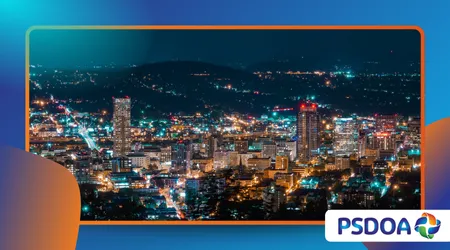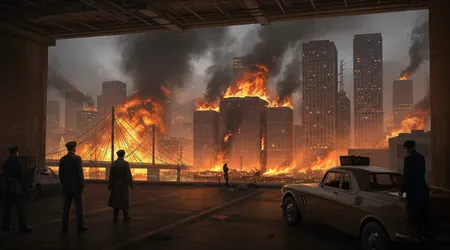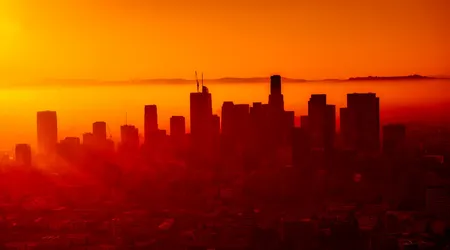The Great Fireproof Cities Plan That Never Happened

Great fireproof cities plan that envisioned urban landscapes immune to flames sounds like a utopian dream, doesn’t it?
Anúncios
In the early 20th century, architects, engineers, and city planners dared to imagine cities built to withstand fire’s destructive force.
This ambitious idea, born from devastating urban fires like the Great Chicago Fire of 1871 and the San Francisco Fire of 1906, aimed to revolutionize how we design cities.
Yet, despite its promise, the great fireproof cities plan that captivated visionaries never fully materialized. Why did such a bold vision fade into obscurity?
This article dives into the origins, challenges, and lasting lessons of this forgotten blueprint, exploring why it remains relevant in 2025 as wildfires and urban density reignite the need for resilient design.
Anúncios
Through historical insights, modern parallels, and practical examples, we’ll uncover what could have been and what still might be.
The story begins in an era when cities burned with alarming frequency. Wooden structures, poor infrastructure, and lax regulations fueled catastrophic blazes.
The great fireproof cities plan that emerged wasn’t just about preventing fires but about reimagining urban life. Planners proposed fire-resistant materials, wider streets, and innovative water systems to protect growing populations.
Today, as Los Angeles grapples with the costliest wildfires in U.S. history estimated at over $200 billion in damages in January 2025 these ideas feel strikingly prescient.
This introduction sets the stage for a deep dive into a vision that could have reshaped our cities, urging us to reconsider its relevance in a warming world.
The Birth of a Fireproof Vision
Devastating fires in the 19th and early 20th centuries sparked the great fireproof cities plan that sought to end urban infernos.
Chicago’s 1871 fire destroyed 17,000 buildings, leaving 100,000 homeless. San Francisco’s 1906 blaze razed 28,000 structures.
These tragedies exposed the fragility of wooden cities. Architects like Daniel Burnham proposed stone and brick construction, firebreaks, and advanced water systems. The vision wasn’t just about materials it was about rethinking urban layouts to prioritize safety.
Imagine a city where every building resists flames, streets act as barriers, and water flows instantly to quench fires. This was the dream.
++ Tesla’s Earthquake Machine: Real Invention or Urban Legend?
Planners studied London’s 1666 fire, which led to its rebuilding with stricter codes. They envisioned similar reforms globally.
Yet, the great fireproof cities plan that inspired hope faced resistance. Costly materials and complex regulations clashed with rapid urbanization’s demands. The vision began as a bold response to tragedy but struggled against practical realities.
Despite early enthusiasm, the plan’s scope was staggering. Retrofitting entire cities required political will, funding, and public support often in short supply.
Cities prioritized quick rebuilding over long-term resilience. For example, Chicago rebuilt rapidly post-1871, but many new structures ignored fireproofing principles.
The urgency to recover trumped visionary planning, setting a pattern that echoed through history.

Why the Plan Faded
Economic pressures derailed the great fireproof cities plan that promised safety. Fire-resistant materials like concrete and steel were expensive, deterring developers.
Cities, eager to grow, favored cheap, fast construction. In 1906, San Francisco rebuilt with wood despite its fire-prone history. Short-term profits often outweighed long-term safety, a choice that haunts modern cities.
Political inertia also played a role. Implementing fireproof codes required unified governance, but fragmented city councils resisted change. Vested interests timber industries, for instance lobbied against costly reforms.
The great fireproof cities plan that demanded systemic overhaul clashed with entrenched power structures. By the 1920s, the vision was largely shelved, overshadowed by skyscrapers and sprawling suburbs.
Also read: Forgotten Sound Mirrors: Britain’s Early Warning System Before Radar
Public perception further undermined the plan. Residents, wary of higher taxes or disrupted lives, resisted sweeping changes.
A 1910 New York Times article noted public skepticism about “overly ambitious” fireproofing schemes. People wanted normalcy, not revolution.
This tension between bold ideas and human resistance stifled progress, leaving the plan as a footnote in urban history.
Modern Echoes of a Forgotten Idea
Fast-forward to 2025, and the great fireproof cities plan that feels eerily relevant. Wildfires, intensified by climate change, threaten urban areas.
Los Angeles’ recent fires destroyed 12,000 structures, highlighting the need for resilience. Modern architects revisit fireproofing with new tools: fire-resistant coatings, smart sensors, and green roofs. These echo the original plan’s spirit, updated for today.
Consider Paradise, California, rebuilt after the 2018 Camp Fire. New homes use fire-resistant siding and sprinkler systems, proving small-scale success.
Yet, scaling these innovations city-wide remains elusive. Urban sprawl pushes development into fire-prone zones, repeating past mistakes. The great fireproof cities plan that once failed could guide us, but only if we prioritize collective safety over profit.
Read more: The Fax Machine That Preceded the Telephone by 30 Years
Technology offers hope. Drones now monitor wildfire risks, and AI predicts fire paths, enabling proactive defense.
Cities like Boulder, Colorado, experiment with “fire-smart” zoning, limiting construction in high-risk areas. These steps mirror the old plan’s intent but leverage 21st-century tools.
Still, without bold policy changes, these efforts risk remaining fragmented, much like their historical predecessor.
Lessons for Today’s Cities
What can 2025 learn from this forgotten vision? First, resilience requires investment. Fireproof materials and smart infrastructure cost upfront but save billions long-term.
Los Angeles’ $200 billion wildfire losses underscore this. Second, urban planning must integrate nature. Greenbelts and firebreaks, as proposed in the original plan, remain effective. Finally, public buy-in is crucial education campaigns can shift perceptions.
History shows that half-measures fail. Post-1906 San Francisco ignored fireproofing, and fires returned. Today, cities must commit fully to resilience.
For example, Sydney, Australia, uses fire-resistant urban design after its 2019-2020 bushfires. This practical approach blending old ideas with new tech offers a model. Why not apply it globally?
The challenge lies in balancing growth with safety. Urban populations will hit 6 billion by 2045, per UN projections. Dense cities amplify fire risks, yet developers resist restrictive codes.
Revisiting the great fireproof cities plan that failed could inspire policies that incentivize safe construction, like tax breaks for fire-resistant materials or stricter zoning laws.
A New Vision for Fire-Resilient Cities

Could a modern great fireproof cities plan that succeed where the original faltered? Imagine a city like Los Angeles adopting a hybrid model: fire-resistant buildings, AI-driven fire detection, and community firebreaks.
This isn’t science fiction it’s feasible with current technology. Cities like Lisbon, Portugal, already use fire-resistant urban forests to shield neighborhoods.
Policy innovation is key. Tax incentives could encourage developers to prioritize safety. Public-private partnerships might fund retrofitting projects, as seen in Toronto’s green roof initiatives.
Community engagement, like workshops teaching fire-safe landscaping, could build grassroots support. These steps transform the old plan into a 2025 reality.
To illustrate, picture a neighborhood in Denver adopting a “fireproof block” model. Homes use concrete facades, streets double as firebreaks, and sensors alert firefighters instantly.
This micro-scale plan could scale up, creating resilient urban networks. The original vision’s failure teaches us: incremental change works better than utopian overhauls.
The Cost of Inaction
Ignoring fireproofing has dire consequences. In 2024, U.S. wildfires burned 8 million acres, emitting 1,940 megatonnes of carbon monoxide. These stats aren’t just numbers they’re a warning.
Unchecked urban fires pollute air, destroy economies, and displace communities. The great fireproof cities plan that never happened reminds us: prevention is cheaper than recovery.
Consider an analogy: building a fireproof city is like vaccinating a population. Initial costs and resistance fade when disaster strikes.
Cities that invest in resilience like Tokyo, with its earthquake-proof skyscrapers thrive post-crisis. Why can’t we apply this mindset to fires? The answer lies in political courage and public will.
Finally, global trends demand action. Climate change fuels fiercer wildfires, and urban sprawl increases exposure.
By 2025, 67% of European mayors prioritize climate action, including fire resilience. Adopting elements of the great fireproof cities plan that faded could align cities with these goals, creating safer, sustainable futures.
| Fireproofing Strategy | Historical Example | Modern Application | Estimated Cost (2025) |
|---|---|---|---|
| Fire-resistant materials | Chicago post-1871 | Paradise, CA homes | $10,000-$50,000/home |
| Firebreaks | London 1666 codes | Sydney urban design | $1M-$5M/km |
| Smart fire detection | N/A | Boulder AI sensors | $500-$2,000/unit |
| Greenbelts | Proposed 1906 | Lisbon urban forests | $100,000-$1M/hectare |
Conclusion: Rekindling a Lost Vision
The great fireproof cities plan that once promised indestructible cities wasn’t just a dream it was a roadmap we ignored. Its failure wasn’t due to flawed ideas but to human shortsightedness.
In 2025, as wildfires ravage urban edges and climate change amplifies risks, this forgotten plan offers lessons.
Cities like Los Angeles, reeling from $200 billion in damages, can’t afford to repeat past mistakes. By blending historical wisdom with modern tech fire-resistant materials, AI, and smart zoning we can build resilient urban futures.
The question isn’t whether we can afford to act, but whether we can afford not to. Let’s rekindle this vision before the next blaze consumes our chance.
This isn’t just about buildings; it’s about lives, economies, and legacies. The great fireproof cities plan that never took hold challenges us to think bigger.
From Denver’s fireproof blocks to Lisbon’s urban forests, practical steps exist. Will we seize them, or let history repeat itself? The choice is ours, and the flames won’t wait.
Frequently Asked Questions
Why did the great fireproof cities plan fail?
Economic costs, political resistance, and public skepticism halted the plan. Developers favored cheap materials, and cities prioritized rapid rebuilding over long-term safety.
Can modern cities adopt fireproofing today?
Yes, with fire-resistant materials, AI sensors, and smart zoning. Cities like Paradise, CA, and Sydney show it’s feasible, though scaling remains a challenge.
What are firebreaks, and why do they matter?
Firebreaks are wide streets or green spaces that slow fire spread. They’re critical for urban resilience, as seen in Sydney’s post-bushfire designs.
How do wildfires impact cities in 2025?
Wildfires destroy homes, pollute air, and cost billions. Los Angeles’ 2025 fires caused $200 billion in damages, underscoring the need for fireproofing.
What can individuals do to support fireproof cities?
Advocate for stricter codes, support fire-resistant retrofitting, and learn fire-safe landscaping. Community engagement drives policy change, as seen in Toronto’s green initiatives.
